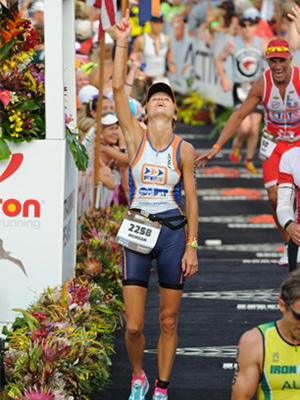Dr. Morgan Busko crossing the finish line of the IRONMAN World Championship.
Every year, approximately 80,000 men and women join an elite group of endurance athletes who complete IRONMAN long distance triathlons by running 26.2 miles, biking 112 miles, and swimming 2.4 miles. Of those, only three percent qualify for the ultimate race – the IRONMAN World Championship in Hawaii. Morgan A. Busko, MD, a sports medicine doctor at NewYork-Presbyterian/
“Completing an ironman requires one to be physically, mentally, and spiritually primed. It takes a certain desire, discipline, and execution to be able to achieve that state. The race itself is really a celebration of all the hard work and self-discipline that goes into getting to the starting line,” she says.
Dr. Busko understands how her patients feel when they are injured – she’s experienced a fair share of injuries herself.
“My performance breakthroughs and athletic highs often came after an injury or pregnancy,” says Dr. Busko. “When we first experience an injury, we can never foresee the path that will emerge.”
She is acutely aware of the downward spiral that an injury can set off for people who are accustomed to an active lifestyle. And while most of her patients are not elite athletes, they are people who love and thrive on an active lifestyle. And whether their chosen sport is running or cycling or playing team sports, they all have one thing in common when they are injured: they want to get back in the game.
“I can empathize with my patients who have a deep desire to return to an active lifestyle, and that is one thing that pushes me as a doctor,” says Dr. Busko. “I want them to get back to sports as much as they do and I am going to work my hardest to get them there as quickly and safely as possible. I strive to empower my injured patients to understand their injury and to truly believe that the best is yet to come.”
Athletic Experience Informs Medical Practice
Dr. Busko running during an endurance event
Training for endurance sports, or any type of physical activity, opens you up to injuries, and Dr. Busko is no stranger to dealing with them. She’s experienced several injuries and those experiences have influenced how she works with her patients.
She was even introduced to this career after a series of injuries herself, which lead her to seeking medical care from a sports medicine physician while she was in medical school. “I started shadowing his sports medicine practice, and I realized that it was a special field in which I could combine my love for endurance sports with my vocation, all while promoting a healthy active lifestyle in my community,” says Dr. Busko.
“One thing I figured out is that every patient requires a different approach to treatment of injuries and training. I try to emphasize to my patients the importance of listening to your body. Make a daily habit of checking in with your body, modify the plan if something doesn’t feel right, so that we can prevent small injuries from escalating,” she says.
Dr. Busko has learned this the hard way during her athletic career. After a year of running about 50 to 60 miles per week, she developed proximal hamstring tendinopathy, a common overuse injury among runners, and was not rehabilitating well. The standard strength building exercises for this condition were not working and she grew increasingly frustrated, unable to run for many months. She returned to the basics and found a simple set of exercises designed to teach the body to fire the gluteal muscles more effectively and was eventually able to slowly progress back to running.
Balancing Training and Recovery
Developing the right treatment plan for a patient often starts, at least for Dr. Busko, with a conversation. Dr. Busko asks her patients about how they spend their day, what kind of work they do, what their workouts are like, and what their athletic goals are. She also assesses how much they are training and recovering.
Morgan A. Busko, MD
“I often tell someone who is diagnosed with an overuse injury or overtraining syndrome that it’s not that they can never train that much in the future. This volume or this load is not impossible for their body. But if an athlete is not able to optimize the recovery phase of training and the preventative aspect of sport, then the training load may have been what resulted in the injury,” she says.
Last year, Dr. Busko treated a NewYork-Presbyterian/
“I treated him in the office with a platelet rich plasma injection and was one of the few who encouraged him not to withdraw from the race as I believed there was the potential that he could still finish it, despite how close the injury was to the race and the way it precluded him from training during the last few weeks,” she says. “I guided him with cross training tips, trials at returning to running, and ultimately his decision to race. He finished the 100 miles without concern for his hamstring and earned the famous belt buckle of success.”
One thing Dr. Busko rarely likes to do, except when it is necessary, is to take her patients out of physical activity completely. Patients with injuries to the lower extremities, for example, can lift weights from a seated position, use an arm bike for cardio, pool run, and may even be able to swim with a pull buoy using their arms to propel them.
“If circumstances allow, I will find ways for them to be active that won’t make their injury worse,” says Dr. Busko, noting that there is a body of research that shows that staying active during recovery can be beneficial. “When you are active your body releases cytokines and other inflammatory mediators which can assist in recovery.”
Never Stop Moving
Not only is staying active beneficial for healing an injury, it’s a critical part of the recovery process for the rest of the person as well, notes Dr. Busko.
“It is truly amazing what exercise can do for every organ in your body,” she says, noting that, in addition to the well-known physical benefits on the musculoskeletal system, exercise has been shown to improve circulation, lower blood sugar levels, and stimulate neurotransmitters that promote feelings of wellbeing
Being active reduces anxiety, boosts people’s mood, and is often one of the factors that helps keep people performing their best in the rest of their life. Training for and competing in running races and triathlons, according to Dr. Busko, are part of how she stays at the top of her game outside of her sport. “As parents of three small children, my husband and I find that prioritizing each other’s active time is one of the best things we can do for our family, our careers, and our well-being. It is immensely important for me to show my children and my community what it means to enjoy an active life.”
“Exercise and physical activity truly brings me great joy,” says Dr. Busko. “I believe that joy spills over into other aspects of my life and it provides enormous positive energy for my day. I think that positive energy helps me to enjoy what I am doing, and my hope is that my patients feel that as well.”







